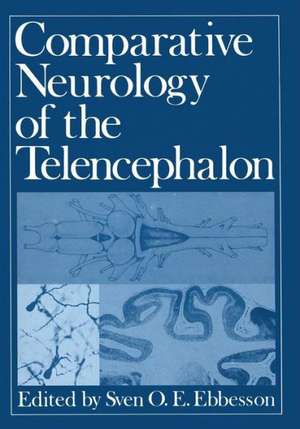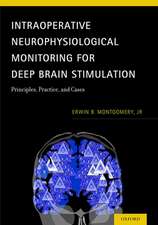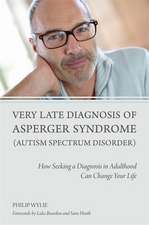Comparative Neurology of the Telencephalon
Editat de Sven O. Ebbessonen Limba Engleză Paperback – 8 oct 2011
Preț: 388.68 lei
Preț vechi: 409.13 lei
-5% Nou
Puncte Express: 583
Preț estimativ în valută:
74.38€ • 76.84$ • 61.91£
74.38€ • 76.84$ • 61.91£
Carte tipărită la comandă
Livrare economică 25 martie-08 aprilie
Preluare comenzi: 021 569.72.76
Specificații
ISBN-13: 9781461329909
ISBN-10: 1461329906
Pagini: 532
Ilustrații: XXII, 506 p.
Dimensiuni: 178 x 254 x 28 mm
Greutate: 0.91 kg
Ediția:Softcover reprint of the original 1st ed. 1980
Editura: Springer Us
Colecția Springer
Locul publicării:New York, NY, United States
ISBN-10: 1461329906
Pagini: 532
Ilustrații: XXII, 506 p.
Dimensiuni: 178 x 254 x 28 mm
Greutate: 0.91 kg
Ediția:Softcover reprint of the original 1st ed. 1980
Editura: Springer Us
Colecția Springer
Locul publicării:New York, NY, United States
Public țintă
ResearchCuprins
1 On the Organization of the Telencephalon in Elasmobranchs.- I. Introduction.- II. Organization of Elasmobranchs.- III. Brain Weight-Body Weight Ratio.- IV. Telencephalic Organization in General.- V. Olfactory Input.- VI. Visual Input.- VII. Representation of Other Sensory Systems in the Telencephalon.- VIII. Telencephalic Efferent Pathways.- IX. Conclusion.- X. References.- 2 Telencephalic Function in Elasmobranchs: A Behavioral Perspective.- I. Use of Sharks in Comparative Neuropsychology.- A. Phylogenetic Advantages.- B. Neuroanatomical Features.- C. Behavioral Repertoire.- II. The Reign of Olfaction.- A. Origins of the “Smell Brain”.- B. Multimodal Representation.- III. Telencephalic Involvement in Visual Discrimination.- A. Experimental Evidence.- B. Nature of the Deficit.- C. Performance Characteristics of Normal Sharks.- IV. References.- 3 New Observations on the Organization and Evolution of the Telencephalon of Actinopterygian Fishes.- I. Introduction.- A. The Fishes.- B. The Telencephalon.- II. Species Studied.- III. Quantitative Considerations.- IV. Normal Morphology.- A. Olfactory Bulb.- B. Area Ventralis Telencephali (V) or Subpallium.- C. Area Dorsalis Telencephali (D) or Pallium.- D. Summary and Discussion.- V. Olfactory Bulb Projections.- A. Methods.- B. Results.- C. Discussion.- VI. Histochemistry.- A. Introduction.- B. Methods.- C. Results and Discussion.- VII. General Discussion.- A. Previous Interpretations of the Telencephalon.- B. A New Hypothesis.- C. Evolutionary Considerations.- VIII. References.- 4 The Telencephalon of Teleosts.- I. Introduction.- II. Terminology.- III. Gross Anatomy and Cytoarchitecture.- IV. Olfactory Tract Projections.- V. Nonolfactory Efferent and Afferent Projections.- VI. Behavior following Ablations.- VII.Regeneration.- VIII. Conclusion.- IX. References.- 5 Projections of the Teleostean Telencephalon.- I. Introduction.- II. Commissural Fibers.- III. Projection to Pretectum and Optic Tectum.- IV. Medial Forebrain Bundle.- V. Projection to Nucleus Rotundus or Prethalamicus.- VI. Strio-lobar Bundle.- VII. Lateral Forebrain Bundle.- VIII. Projection to the Central Gray of Brain Stem.- IX. Contralateral Descending Projection.- X. Final Considerations.- XI. References.- 6 The Fish Telencephalon and Its Relation to Learning.- I. Introduction.- A. Evolutionary Considerations.- B. Anatomy.- II. Ablation of the Telencephalon.- A. General Effects.- B. Habituation.- C. Classical Conditioning.- D. Avoidance Problems.- E. Approach Problems.- III. Electrical Recording from the Telencephalon.- A. Olfaction.- B. Ascending Influences.- IV. Electrical Stimulation of the Telencephalon.- A. Effects on General Behavior and on Feeding.- B. Reinforcement Effects.- C. Effects on Other Brain Areas.- D. Effects on Learning.- V. Theories of Telencephalic Function.- A. Introduction.- B. Arousal.- C. Attention and Consolidation.- D. Secondary Reinforcement Processing.- E. Conclusions and Prospects.- VI. References.- 7 Telencephalon and Behavior in Teleost Fish: A Neuroethological Approach.- I. Introduction.- A. Ethological Introduction.- B. Neuroanatomical Introduction.- II. Methods of Studying Telencephalic Functions.- A. Ablation and Specialized Lesions.- B. Stimulation and Recording.- C. Histological Control.- III. Behavioral Changes following Ablation and Specialized Lesions of the Telencephalon.- A. Introduction.- B. Nesting Behavior.- C. Sexual and Parental Behavior.- D. Aggressive Behavior.- IV. Behavioral Observations during Stimulation of and Recording from the Telencephalon.- A. Nesting Behavior.- B. Sexual and Parental Behavior.- C. Aggressive Behavior.- D. Arousal and Reward.- V. Regenerative Aspects.- VI. Concluding Remarks.- VII. References.- 8 Organization of the Amphibian Telencephalon.- I. Introduction.- A. The Amphibia.- B. The Amphibian Telencephalon—Primitive or Degenerate?.- II. Species Studied.- III. Normal Morphology.- A. Olfactory Bulbs.- B. Pallium.- C. Subpallium.- IV. Organization of the Olfactory System.- A. Olfactory Organs.- B. Olfactory Projections.- C. Olfactory Mediated Behaviors.- V. Ascending Telencephalic Afferents.- A. Anterograde Degeneration Studies: Regional Sources of Telencephalic Afferents.- B. Cellular Sources of Telencephalic Afferents: The Horseradish Peroxidase Method.- C. Ultrastructure of the Ascending Afferents.- D. Other Ascending Afferents: A Quintofrontal Tract in Amphibians?.- E. Functional Significance of Telencephalic Afferents.- VI. Some Intratelencephalic Connections in Amphibians.- A. Projections of the Pallium.- B. Projections of the Subpallium.- VII. Telencephalic Efferents.- VIII. Amphibian Telencephalic Organization.- A. Telencephalic Organizational Pattern.- B. Comparisons with Other Vertebrates.- IX. References.- 9 The Telencephalon of Snakes.- I. Introduction.- II. Normal Anatomy.- A. Gross Appearance.- B. Lateral Ventricle.- C. Main Olfactory Bulb.- D. Main Olfactory Tract.- E. Accessory Olfactory Bulb.- F. Accessory Olfactory Tract.- G. Retrobulbar Region.- H. Septum.- I. Cortical Mantle.- J. Dorsal Ventricular Ridge.- K. Paleostriatum.- L. Archistriatum or Amygdala.- M. Preoptic Area.- III. Fiber Connections.- A. Main Olfactory Bulb.- B. Accessory Olfactory Bulb.- C. Nucleus Sphericus.- D. Medial Cortex.- E. Dorsal Cortex.- F. Lateral Cortex.- G. Septum.- IV. Concluding Remarks.- V.References.- 10 Cytoarchitectonic and Connectional Organization of the Lacertilian Telencephalon with Comments on Vertebrate Forebrain Evolution.- I. Introduction.- II. Anatomy of the Lacertilian Forebrain.- III. Connections of the Lacertilian Forebrain.- A. Ascending Sensory Projections.- B. Intrahemispheric Corticocortical Projections.- C. Interhemispheric Corticocortical Connections.- D. Descending Telencephalic Projections.- IV. Forebrain Organization in Other Reptiles and Birds.- A. Cortex.- B. Dorsal Ventricular Ridge.- V. Telencephalic Connections in Iguana and Gekko.- A. Ascending Projections.- B. Cortical Efferent Projections.- VI. Discussion.- A. Dorsal Ventricular Ridge.- B. Dorsal Cortex.- C. Trends in Forebrain Evolution.- VII. References.- 11 Parallels in the Organization of Auditory and Visual Systems in Crocodiles.- I. Introduction.- II. Parallels in the Organization of Midbrain Auditory and Visual Areas in Caiman.- III. Parallels in the Organization of Thalamic Auditory and Visual Regions in Caiman.- IV. Other Parallels in the Organization of Auditory and Visual Systems That Synapse in the Midbrain of Caiman.- V. Comparison with Other Reptiles and Birds.- VI. Comparison with Mammals.- VII. Summary.- VIII. References.- 12 Behavioral Studies of Telencephalic Function in Reptiles.- I. Introduction.- II. Subpallium.- A. Introduction.- B. Terminology.- C. Lesion Studies of Subpallial Function: 1823 to 1967.- D. Lesion Studies of Subpallial Function: 1968 to the Present.- E. Stimulation Studies of Subpallial Function.- F. Summary.- III. Pallium.- A. Introduction.- B. Stimulation Studies.- C. Ablation Studies.- IV. Discussion.- A. Telencephalon as an Arousal System.- B. Visual Telencephalon.- C. Function of Dorsal Cortex.- V. References.- 13 Functional Organization of the Avian Telencephalon.- I. Introduction.- II. Development and Organization.- III. Bilateral Hemispherectomy.- IV. Lesions of the Tectofugal Visual Pathway.- V. Thalamofugal Visual Pathway and Wulst.- VI. Combined Lesions of Tectofugal and Thalamofugal Visual Structures.- VII. Wulst Lesions and Reversal Learning.- VIII. Extensive Hyperstriatal Lesions.- IX. Interhemispheric Relations.- X. Archistriatum and Agonistic Behavior.- XI. Nucleus Basalis and Feeding Behavior.- XII. Central Control of Birdsong.- XIII. Summary and Conclusions.- XIV. References.- 14 Morphological Correlates of Specialized Elaborations in Somatic Sensory Cerebral Neocorte.- I. Introduction.- II. Gyral Configuration in Somatic Sensory Cerebral Cortex Related to Behavioral Specialization.- A. Proposed from Procyonids.- B. Tested in Marsupial Wombats.- III. Subcortical Correlates of Gyral Formations: Lobules.- A. Ventrobasal (Somatic Sensory) Nucleus of Thalamus.- B. Cuneate-Gracile Nuclear Complex of the Medulla.- C. What Are Lobules?.- IV. Role of Receptors in the Development of Lobules.- A. Relation of Receptor Density to Presence and Volume of Lobules.- B. Absence of Cuneate-Gracile Lobules following Early Receptor Removal.- V. Intracortical Correlates of Sensory Specialization: Barrels and Cellular Condensations.- A. Barrels in Layer IV of Sensory Neocortex.- B. Role of Receptors in the Development of Barrels.- C. Regions of Cellular Condensation and Rarefaction Related to Sensory Maps in Layer IV of Sensory Neocortex.- VI. Possible Relation of Barrels and Other Regions of Cellular Condensation to Gyral Formations.- VII. Summary.- VIII. References.- 15 Thalamocortical Relationships in Echidna (Tachyglossus aculeatus).- I. Introduction.- II. Materials and Methods.- A. Subjects.- B. Surgical Procedures.- C. Histological Preparation.- D. Identification of Cortical Lesions and Thalamic Degeneration.- III. Results.- A. Cortical Organization.- B. Thalamic Nuclear Organization.- C. Thalamocortical Relationships.- D. Unaffected Thalamic Nuclei.- E. Three-Dimensional Organization of Echidna Thalamus.- IV. Discussion.- A. Variations in Thalamocortical Circuit Connections among Vertebrates: The Search for Homologies.- B. Theoretical Concepts.- V. References.- 16 A Comparative Survey of Visual Cortex Organization in Mammals.- I. Introduction.- II. Survey of Extant Mammals.- A. Monotremes.- B. Marsupials.- C. Edentates.- D. Lagomorphs and Elephant Shrews.- E. Insectivores.- F. Archonta.- G. Carnivores.- H. Ungulates.- I. Rodents.- III. Conclusions.- IV. References.














